Skoda Citigo 1.0 MPI Monte Carlo

Welcome to London, Citigo
We say hello to Skoda's tiny urban runabout - the Citigo. Is it the perfect car for the capital? We'll find out over the next six months.
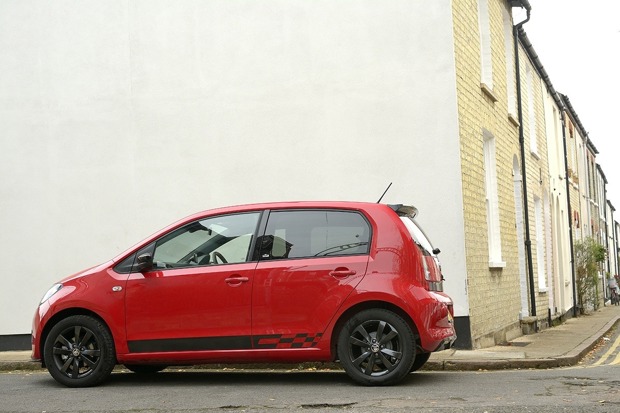
Date: 5 November 2014 | Current mileage: 121 | Claimed economy: 62.8mpg | Actual economy: 49.7mpg
A Skoda Citigo has just arrived to replace our Citroen DS3. On the face of it, that’s not particularly good news. The Citigo is down 95PS and its roof doesn’t come off, for starters. But on the plus side it’s little and nimble, it has four doors instead of two and it has a proper boot, rather than a tiny slot.
So for someone who lives in a fairly built up bit of London, it’s actually pretty good news. The Citigo is arguably one of the best cars for this kind of environment because it’s easy-to-park, cheap to insure, good on fuel and – despite its dimensions – actually fairly practical, at least for a couple.
Our particular Citigo is a Monte Carlo, which means it gets fancy-looking black alloy wheels, black stripes and an interior finished in red and black, plus a few Monte Carlo badges here and there. The Monte Carlo edition is based on the SE model, so it gets some useful gear including air conditioning.
We have a few extras fitted to ours. There’s a double-layer boot floor - which may or may not be useful - along with a space-saver spare wheel, which I hope won’t ever be needed. We also specified the portable infotainment device (PID), which I already know is extremely handy.

The Citigo is great for tight spaces
This bundles most of the functionality you’d expect of an expensive, integrated infotainment system into a clever little device that sits atop the dashboard. Our car also has an active emergency braking system – something else that I hope won’t ever be needed.
So far the Citigo hasn’t covered many miles, but it has coped well with short hops around West London, where it seems perfectly at home. The 60PS petrol engine is capable enough when it comes to speedy green-light starts and the boot, while far from giant, is far more useful than the boot on our old DS3 Cabrio.
Over the coming months the Citigo will be used in far more diverse environments, with plenty of motorway miles due, along with twisting country roads and maybe even a couple of high-mileage adventures. We’ll also look at some rivals. There are plenty to choose from, with Toyota, Citroen, Peugeot and Renault in on the act, not to mention the near-identical Volkswagen Up and SEAT Mii.
Of course, we’ll also look at just how well the Citigo copes with the city – it should do a pretty well considering its name. On first impressions it is coping well – turning around in narrow streets, slotting into parking spaces and judging gaps is very easy indeed. Let’s hope it keeps impressing for the next six months.
The blessing (and curse) of the personal infotainment device
At £300 should you choose the optional PID, or is an everyday aftermarket navigation system up to the same job?
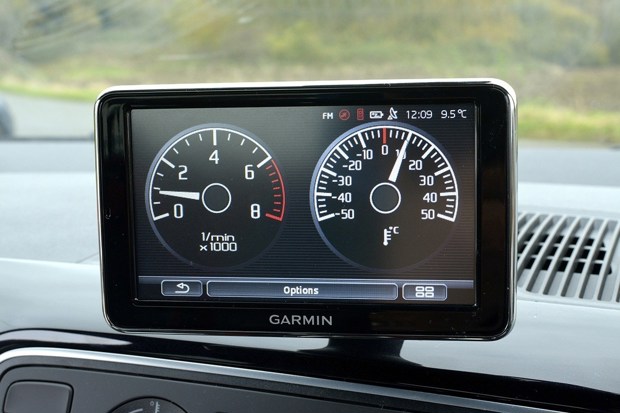
Date: 19 November 2014 | Current mileage: 169 | Claimed economy: 62.8mpg | Actual economy: 50.3mpg
The PID (personal infotainment device) fitted to our Citigo is pretty clever on the face of it. Fundamentally it’s a removable navigation system, like any number of TomTom or Garmin units, but it offers a lot more functionality.
For starters you don’t have to trail an irritating long wire from the 12V socket to the windscreen, since the PID attaches to a dedicated mount in the centre of the dashboard. This swivels so you can point it at either the driver or the passenger.
As a navigation it’s decent, if not the best thing in the world. It has the advantage of being portable, so you can programme it at home ahead of time instead of fiddling around in the car trying to get mobile reception to look up a post code. On the subject of post codes, the system accepts full UK ones, unlike the system in our old DS3 - so you don’t have to know the house number and street.
The PID has another party trick – it saves your location when you park. That’s useful in an unfamiliar town because you can then navigate back to your car’s last location on foot using the PID. Battery life isn’t too bad and the device itself is light and small enough to fit into a coat pocket or handbag.

Lost? The PID shows you where you last parked
But the PID is more than just navigation. It also connects to the car to show fuel economy, oil temperature and various other trip functions, plus it has Bluetooth. That means you can hook up to an iPod or phone to make calls, access your music or connect to Spotify. The PID shows music track names and can be used to skip tracks without touching your phone or iPod.
It’s pretty nifty, but it isn’t perfect. Setting up Bluetooth sometimes results in the PID simply shutting down and resetting, especially when there are a couple of paired devices for it to choose from. That means waiting an extra couple of minutes then trying again, which is a bit frustrating if you just want to get in and drive.
It’s not the only issue with the PID. It has an old-fashioned, non-capacitive touchscreen, so you really have to give it a good prod. Even then it’s a bit slow to respond, so if you get ahead of yourself when entering a post code you’ll find yourself inputting one too many digits and having to start over.
The fact you can remove the PID is a blessing a lot of the time – but it’s also a curse. It might look integrated at a glance, but the fact it can be simply unclipped means there’s always a worry about thieves – so you really do have to remove it from the car and put it somewhere safe when you park, whether you like it or not.
But on the whole the PID is a great device. For £300 (or free on Elegance trim) it offers enough extra functionality over a typical aftermarket system, but without costing significantly more. For a car like the Citigo, which is designed to offer value for money, it’s the perfect middle ground between an expensive integrated infotainment system and a cheap, 12V plug-in nav.
Will the Citigo save you money?
People buy cars like the Citigo because they're cheap - not only to buy but also to run. Will it save you money?
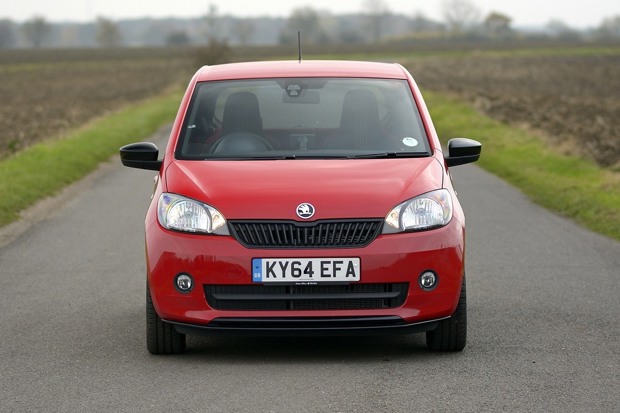
Date: 3 December 2014 | Current mileage: 463 | Claimed economy: 62.8mpg | Actual economy: 51.3mpg
People tend to buy small urban runabouts like the Citigo because they’re cheap – not just in terms of list price or monthly repayments, but at the petrol pumps too. Given the tumbling cost of petrol recently, every car is cheaper to fill up – but the Citigo is particularly easy on the wallet.
Officially the Citigo is capable of 62.8mpg and, though it doesn’t match that in real world driving, it’s genuinely pretty frugal. According to our Real MPG section most Citigo owners manage around 56.2mpg and that tallies with my own experience depending on where I've been driving.
Most cars tend to get fairly poor fuel economy around town thanks to stop start traffic - but oddly the Citigo does quite well in my experience, despite having no stop/start system. This is possibly down to my journeys taking place at weekends or late at night when London traffic is light.
At higher speeds the economy is slightly less impressive, dropping a few mpg on a long run. Again, this is contrary to what you might expect, but it’s not like the economy takes a nosedive - it’s still perfectly respectable. Slow down to 65mph and it improves appreciably, too.
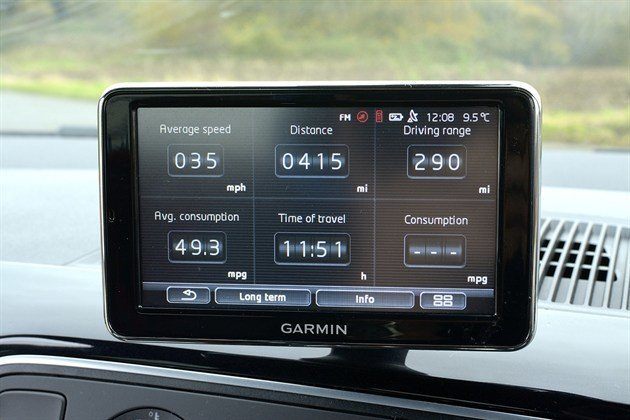
The PID shows economy (which is better since this pic was taken)
The fuel tank itself isn’t particularly large on the Citigo, which means filling up never costs all that much. From a purely psychological point of view that makes it feel even cheaper to run than something like a big diesel with a huge tank that costs £100 to fill.
Another advantage of having a small, frugal car is the cost of car tax, or VED to give it its real name. Our particular Citigo isn’t quite clean enough to make it into VED band A, so annual tax isn’t free – but at £20 for a full year it’s hardly a crippling surprise when the DVLA sends a reminder.
There are more ways to save money with the Citigo. Our Monte Carlo edition might look sporty with its red and black paintwork, but it’s in insurance group 2E. For a learner or first time driver that makes the Citigo a good bet – but an experienced driver will reap the rewards of cheap insurance just as much.
Finally, if you really want to keep your accounts in order, you can also get fixed price servicing packages from Skoda, to include either basic servicing, servicing and maintenance or even servicing, maintenance and tyres. The prices depends on your personal circumstances and fixed price packages really aren’t a requirement, but if you want to keep on top of running costs it makes life much more simple.
To the motorway
The Citigo is designed for town work, but chances are most buyers will have to take to the motorway some time. How does it fare?
Date: 23 December 2014 | Current mileage: 1092 | Claimed economy: 62.8mpg | Actual economy: 51.1mpg
All Citigo models come with a 1.0-litre three cylinder engine, but there are two power outputs on offer – 60PS and 75PS. Ours has the former, which you might think means it’s underpowered and pathetic, but it really isn’t. In fact, it’s a perky, fun little engine and it even works well on the motorway.
The 1.0-litre MPI, to give it its full title, isn’t too remarkable in the world of small cars. It has three cylinders, so sounds quite distinctive, but it does without fancy turbocharging. Normally the downside to this simplicity is a lack of low-down torque, but the Citigo’s engine offers enough flexibility to make motorway cruising fairly relaxed.
At 70mph the engine is reasonably quiet – the Citigo doesn’t feel out if its depth. That said, if you want to overtake a slow mover then you’ll need a lower gear, because peak torque comes in at 3000rpm and peak power at 5000rpm. It’s not a big problem though – the engine never feels strained, nor does it get too loud even when pushed hard.
The Citigo does miss out on cruise control, sadly. That’s not particularly unusual on a small city car like this, but given how at home it is on the motorway it would certainly be a nice thing to have, especially now there are so many 50mph zones on the motorway network.
![]()
The Citigo is surprisingly at home on dual carriageways and motorways
Our Citigo spends most of its time in town, but for those who tend to use the motorway a lot it might be worth spending a little more for the 75PS engine. It has the same peak torque figure but those few extra horsepower will make life a little easier when overtaking – though there isn’t a mammoth difference.
Being a sister car to the Volkswagen Up, it's possible that one day we'll see an even more powerful Citigo too. Volkswagen has announced the Up GT, which is set to get a more powerful turbocharged version of the three-cylinder engine, producing 110PS. This will also get a six-speed transmission instead of of the standard five-speed.
While this will no doubt have a focus on fun, the extra power and torque would make all the difference for overtaking, while a sixth gear ratio will theoretically make cruising a little more subdued and quiet. There's no guarantee this hotter engine will make it into the Skoda, of course - but it would be nice to see a Citigo vRS.
Meanwhile, if you want the 75PS engine you’ll have to go with the Elegance trim and that means spending more money. If you’re buying a Citigo on a budget then you’re restricted to the lower powered engine – but it shouldn’t concern you - 60PS will do the job for most buyers no matter where they drive.
The Citigo is surprisingly good fun
It might have less power than some of the cars I've run in the past, but the Citigo is still a lot of fun.

Date: 6 January 2015 | Current mileage: 1936 | Claimed economy: 62.8mpg | Actual economy: 52.2mpg
I’ve got plenty of experience with fun hatchbacks. In the past i’ve run a 140PS SEAT Leon FR, a 156PS Citroen DS3 and a 140PS diesel MINI – although admittedly the latter was a coupe rather than a hatchback.
So the prospect of a 60PS Citigo wasn’t exactly igniting the fires of excitement – even if it is red and black like the MINI. Surprisingly, though, it has been rather a lot of fun. A few recent journeys involved some tight, twisting country lanes and the Citigo did plenty to entertain, even if it lacks outright pace.
The Monto Carlo might look the part with all its graphics and black alloy wheels, but it also has lowered sports suspension. Quite how much difference this makes is unclear without driving it back-to-back with a standard car, but it certainly seems to make corners fun.
The steering is nicely weighted too, rather unlike the overlight steering of rivals like the Renault Twingo. It isn’t heavy by any means, but it offers enough resistance to make you feel like part of the driving experience, instead of disconnecting you from it.
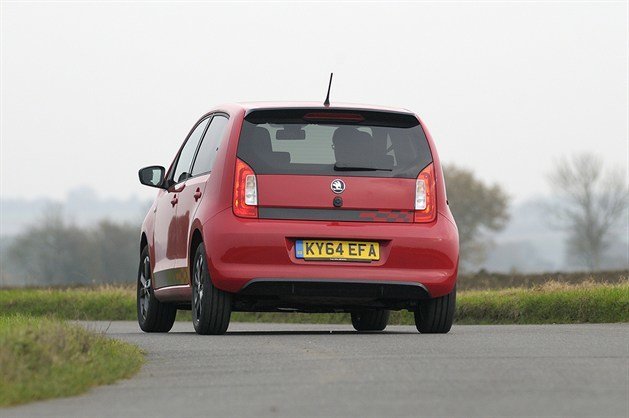
What it lacks in power, the Citigo makes up for in fun
The Citigo feels sharp and nimble, helped by its light weight. However despite being light it feels planted and composed – there’s plenty of traction and little in the way of body roll. The lack of power is something of a blessing on the right road because you can drive hard, which makes the experiece more rewarding - but without breaking the speed limit.
Sadly the lack of power does become a problem when you get stuck behind a dawdling Sunday driver. Overtakes aren’t a matter of pressing the pedal harder – you need some forethought and planning. That’s easier said than done on an unfamiliar road.
It’s not impossible to get past other drivers though, provided you leave plenty of space to accelerate up to speed before pulling out to overtake. Again, this makes driving more involving – although not in a way that every driver will appreciate.
But if you’re familiar with fun hatchbacks you’ll be pleasantly surprised by just how entertaining the little Citigo can be. It won’t win any races of course, but if you can’t afford to insure a more powerful car and you still want to have fun it’s a great choice.
Racking up the miles
We've been racking up hundreds of motorway miles in the Citigo - but rather unlike the proverbial fish out of water, it's coping well.
Date: 23 January 2015 | Current mileage: 3015 | Claimed economy: 62.8mpg | Actual economy: 51.1mpg
It’s been a busy few weeks. Apparently January 2015 is the vogue time for car makers to launch new models, so the Citigo and I have been spending a lot of time together, exploring the diverse British motorway network. There’s been an almost full circumnavigation of the M25, a trip to the beach and a journey to Silverstone.
Surprisingly it hasn’t been a hardship, thanks in no small part to the PID system and my discovery of two things – Spotify and a £7.50 sheet of advanced polymer called a Gecko Pad. It looks like a sheet of gelatine but it actually serves as a non-slip adhesive to hold your phone (or anything else) to the dashboard.
It doesn’t leave a residue on either the phone or the car and when it gets gummed up with fluff you simply wash it and it is as good as new. Apparently its design is inspired by the pads on gecko’s feet and it’s frankly brilliant for keeping things where you want them. I keep my phone attached to it so I can see it at a glance.
Of course, for phone calls and music you don’t really need to see the phone, since it pairs up so well via Bluetooth. Which brings me on to Spotify. Why had I not discovered it before? It’s like a radio station that only plays the music you like but without any annoying presenters.
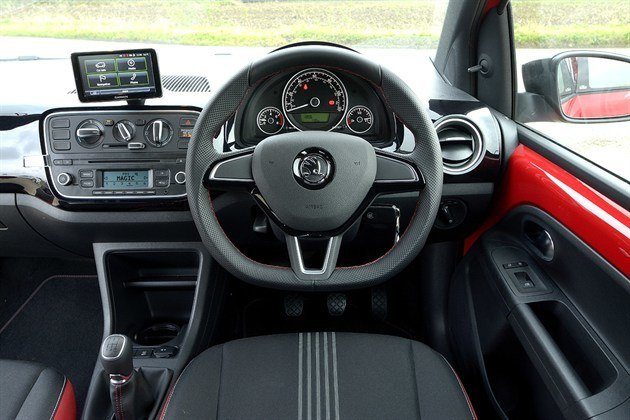
I've been spending a lot of time here...
The Spotify app on my phone connects to the PID perfectly and displays track names and artists, though the functionality isn’t advanced enough to let you choose specific playlists. It also gets confused when – if you’re cheap like me and don’t pay for premium – you run out of track skips.
If that happens then you still get the option to press the skip button, it just doesn’t work. Irritating. There are a few more niggles too – sometimes the playback stops and won’t start again for no immediately obvious reason, but this can usually be fixed by turning the volume up on the phone.
The fact such little irritations can bother me on a motorway journey is testament to how capable the little Citigo is. Sure, it’s not as quiet as a larger car and it does need more forward planning when it comes to overtaking, but it’s pretty hard to fault. I can sit comfortably in it at motorway speeds for hours.
And thanks to impressive connectivity I don’t get bored when I’m at the wheel for two hours or more. Obviously if you spend the majority of your time on the motorway then you’re better off with a larger, quieter and more powerful car, but if you’re bothered the Citigo won’t cope with the odd dual carriageway then stop fretting – there’s no need to worry.
Tiny trio
The Citigo isn't alone. Volkswagen and SEAT also make what is basically the same car at the same factory. What's the difference?
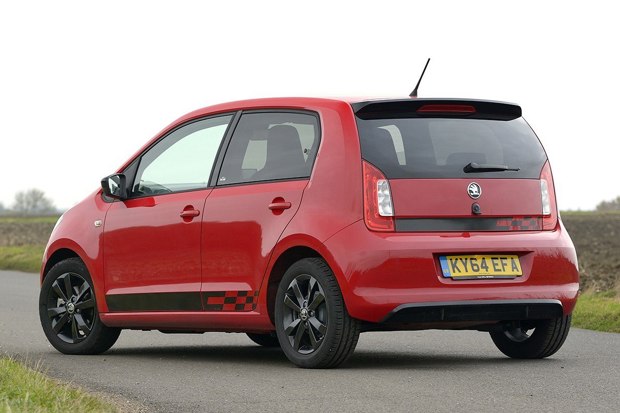
Date: 6 February 2015 | Current mileage: 3263 | Claimed economy: 62.8mpg | Actual economy: 50.6mpg
The Skoda Citigo is part of a trio of little city cars from the Volkswagen group. The factory where the Citigo is made, in Slovakia, also produces the Volkswagen Up and the SEAT Mii. They are all made on the same production line with many of the same components – so what’s the difference?
The SEAT Mii is the cheapest on paper, with the lowest list price of £8195, while the Citigo costs from £8210 and the Volkswagen from £8765. Obviously there is a lot more to the equation than list price though – equipment and monthly rates vary depending on the model you choose.
A huge number of small cars are sold on PCP deals now and there are plenty of offers from all three manufacturers, meaning you can pay as little as £60 per month. It’s tricky to decide who offers the best deal, but, again, the chances are you’ll pay the lowest monthly rate for a SEAT and the highest for the Volkswagen. But there isn’t much in it.
Engines are the same across the range – all three models get a 1.0-litre MPI petrol with a choice of 60PS or 75PS. Driving dynamics, too, are more or less the same, as is practicality and space. Additionally, all three models get the same optional and handy PID device. It really is incredibly difficult to pick between them objectively.
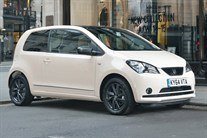

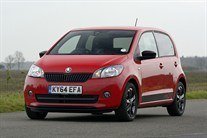
Spot the difference...
So what about subjectively? The Citigo and its two siblings have been on sale for a few years now, so there are various special editions out there to pick from. Our Citigo is a Monte Carlo, which is why it wears such striking red and black paint. The same model is offered in various other colours too and it really does look the part.
But you might well prefer the Volkswagen Street Up, Club Up or Rock up – all three offer unique and fun styling, with various colour combinations, stripe designs and alloy wheel choices. SEAT is in on the act too, with a special edition created with input from fashion company Mango. It is offered in two colours, but for our money it isn’t nearly as distinctive as the specials from Skoda or Volkswagen.
If special editions aren’t your cup of tea then Volkswagen Up has the highest level of customisation of the three cars. There are more choices when it comes to interior upholstery, dashboard colours and alloy wheel designs, so if you really want to create something that feels unique it’s the one to choose.
Having said that, there’s very little in it. Really it comes down to personal preference – which is probably precisely the way Volkswagen Group bosses planned it. Which one do you like the best? Which has the best dealer support in your local area? These are the deciding factors, because really there is nothing else to separate the three
Would I buy a Citigo
We change our vehicle for Our Cars every six months - but if it was time to pick a car to last for a lot longer, would the Citigo do?
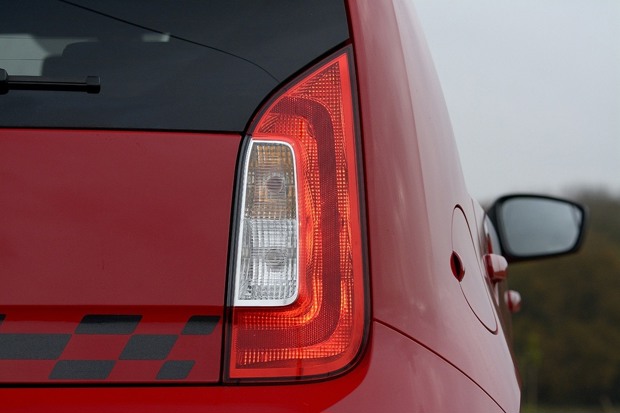
Date: 20 February 2015 | Current mileage: 3635 | Claimed economy: 62.8mpg | Actual economy: 50.5mpg
If you’re a regular reader of the Our Cars section you will know that we change cars every six months. That’s just about long enough to get to grips with a car and learn all of its quirks, but not so long that we end up going over the same things repeatedly – unless they’re really worth mentioning a dozen times of course.
It is also long enough to become attached to a car. Sometimes saying goodbye after six months is pretty heart-wrenching, other times it isn’t too difficult at all. With the Citigo I’m not particularly looking forward to changing, but equally I’m not profoundly attached to it. So perhaps the most important question is this: would I buy one to keep for longer than six months?
The answer is a resounding yes. In fact, of all the cars I have run for the Our Cars section over the past few years, this is the one I would be most likely to buy. Sure, it isn’t particularly speedy or exciting – but it’s honest, simple and capable. It’s also very affordable, even for those without a huge amount of money to spare.
To me that’s perhaps the most important consideration. Previously I have bought very cheap cars aiming to run them on a shoestring budget, but the unexpected always rears its ugly head. It is fine spending £1500 on a car, but when you have to then pay £500 in six months because the ABS fails the appeal fades.

Perhaps if I was in for the long-haul I'd have plainer seats...
Running costs are higher on older models too – annual tax, fuel prices, servicing and MoTs are a pain and never seem to be due when you or your bank wants them. But with the Citigo you can pay an affordable deposit and then an affordable monthly amount for a PCP, knowing your tyres have plenty of tread, the brakes and battery are new, there’s no MoT due and there’s a warranty.
The disadvantage is that you never fully own the car. But does that really matter? Personally I would rather pay monthly for the peace of mind. After the three year deal is up you can usually move straight into a brand new car for another three years without much fuss, too.
Again, that provides the convenience of new tyres, new brakes, low running costs, a fresh warranty and no looming MoT. There are, of course, many other manufacturers offering cars for similar monthly amounts but the Citigo holds plenty of appeal. I’ve already explained how it’s good to drive, well equipped and capable.
But more than that, it simply feels right. When I’m driving it I feel at home – it’s the right size, it’s got the right personality and it has almost all the gadgets I’d want – though if I’m nitpicking I’d quite like cruise control. All that car for less than £100 a month? Count me in.
Con-fused
A cheap 12V charger and a problem with fuses leads to some serious anger issues in the Citigo.

Date: 6 March 2015 | Current mileage: 3263 | Claimed economy: 62.8mpg | Actual economy: 50.6mpg
If I find myself on a long journey without my phone in the car I get deeply frustrated. I need to listen to Spotify or web radio when I’m on the move, I need to check Facebook and Twitter three hundred times when I get to the motorway services and I need to find my way when I get lost. Thankfully none of those things is too bad for battery life.
Something that is bad for the battery is Waze, a sort of interactive free navigation system that interconnects all of its users. It’s fantastic – other people can mark traffic jams as they happen and explain the cause, even with a photograph if they want. It also intelligently plots ideal routes based on the amount of time it takes other users to make similar journeys.
I now almost exclusively rely on Waze to navigate, meaning the perfectly useful PID nav that came with the car is relegated to music duties. That means my phone sits on a none-slip ‘Gecko’ pad on my dashboard with its screen on all the time. And that really takes its toll on battery life.
The obvious solution is to get a 12V charging device, but I have bad luck with those. The coiled-up 1990s looking-one I had spare in a draw broke in half and there is no USB output in the Citigo - unless I can’t find it. So, out of desperation, I bought a socket with two USB outputs for an extortionate amount of money from Beaconsfield services.
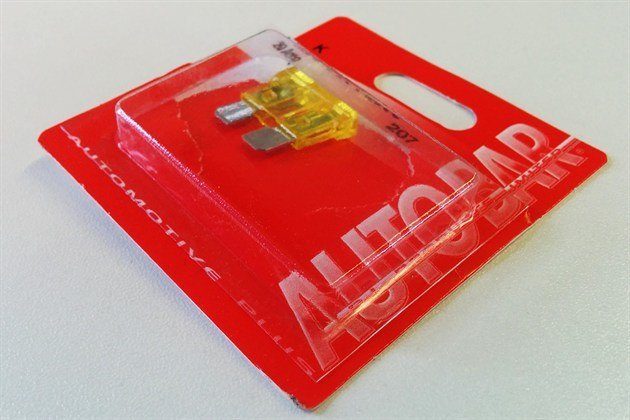
Spare fuses - not standard equipment
Not only was it ludicrously expensive, but I discovered it didn’t work. By this time I was too far away to go back and get a refund, so I pulled over and twisted it every which way, eventually bashing it hard enough to slice my thumb open. This didn’t work either. Apparently the fuse had blown.
After consulting the manual in a layby I found the fusebox – which was actually quite hard – and pulled out the blown fuse. That wasn’t much help though, since Skoda, for some reason, doesn’t provide spare fuses as standard. I considered for at least ten minutes whether or not I actually needed ventilation or interior lighting more than a 12v output.
Eventually came to my senses and went to a car parts shop. Thankfully fuses are cheap and after popping one in I was away with my phone merrily charging – for about 10 minutes until I gently agitated the now infuriating red 12v charger and it popped the fuse. Again.
So I stopped, smashed it to pieces, went to a proper shop and bought a better one for about a third of the price. Since then everything has been fine. But I have learned two lessons from this – Skoda doesn’t provide any spare fuses and motorway services shouldn’t be trusted to sell reliable goods at reasonable prices.
Moving house in the Citigo
You can't do a proper house move in a tiny hatchback, but even so the Citigo surprised with its practicality.
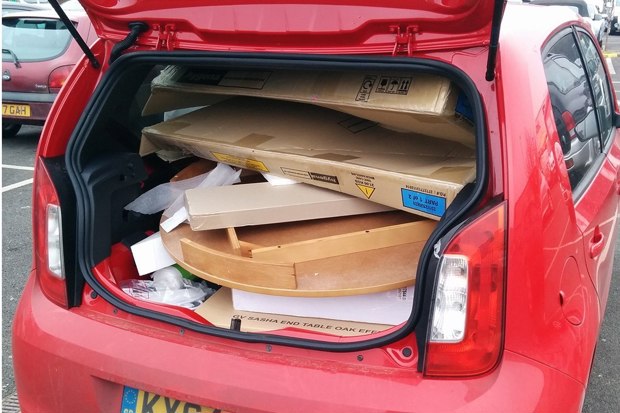
Date: 20 March 2015 | Current mileage: 3895 | Claimed economy: 62.8mpg | Actual economy: 50.3mpg
I just moved house. I didn’t use the Citigo as a removal van because that would be silly - but I did hand the keys for the proper removal van back before it had outlived its usefulness. That means I’ve had to test the limits of the Citigo’s load capacity.
Thankfully the split-fold rear seats are easy to operate and, if you specify the optional two-level boot floor, there is a nice flat load bed with no lip. This is handy when sliding heavy things in and out -but only if they’re narrow enough to fit though the fairly tight hatchback aperture.
One of the two boxes containing our new dining room table wasn’t. The boot aperture is wider at the top so, after struggling to unpack the box in the car park outside Argos, it all fit in. Only after plenty of struggling and obvious laughter from passers-by, though.
In fairness, the Citigo really isn’t meant for carrying kitchen tables, so it is actually quite impressive we got the table in full stop. Loading the rest of our bits and pieces wasn’t too tricky – there really is a decent amount of room with the seats down. Obviously it’s no estate, but how often do you need that much space?

Better than gridlock on the Westway...
Our new house has off-street parking – something we missed out on in the past. Our parking bay has a garden fence on one side and I like to reverse in, which means my door opens against the fence. Here the Skoda’s size is really handy, since I can leave enough of a gap to easily get in and out without getting in the way of other cars.
Another big change since moving is the type of roads. Our rural town is surrounded by fast, single and dual-carriageway A-roads roads and tight, twisting B-roads. Previously the Citigo lived in the urban sprawl of West London yet, despite its little 60PS engine, it is coping fine with the change.
Sure the little engine gets worked harder, thanks to the higher speed limits and the twists and turns, but it very rarely feels out of place. It is certainly more at home in town than it is on a national speed limit route, though. I suppose it’s called a city car for good reason.
Maybe that the more powerful 75PS version would come into its own on faster roads. A little bit of extra power would be handy when cruising at 60mph, even if it is useless in the car park at Sainsbury’s. There’s not much to complain about though – the Citigo is soldiering on fine.
Finding things to annoy me
When our time is coming to an end and we’ve covered all the important bits, we’ve got to start searching out things to complain about.

Date: 3 April 2015 | Current mileage: 4363 | Claimed economy: 62.8mpg | Actual economy: 50.3mpg
The Our Cars section is great for finding little niggles. We spend six months with these cars and in that time it’s easy to find the very best and worst features of a car. This is particularly true when our time is coming to an end and we’ve covered all the important bits, because it means we’ve got to start searching out things to complain about.
But the Skoda doesn’t do anything dramatically wrong – rather it just has a few irritating features that are tedious at their worst. First among which is the mirror adjustment, which is by little stalks rather than electric switches. Fine for the driver’s side and a royal faff for the passenger’s side unless you have someone to help.
The same goes for the electric window switches. There is one on each side, so the driver can’t operate the passenger side window. Sure, this is unlikely to cause any serious issues most of the time but it’s just another one of those things to get on your nerves.
By far the most annoying of these little niggles is the rear parcel shelf. To get things in and out you have to lift it up, which is no real bother since it stays up and out of the way. But if you forget to put it back down then it completely blocks the view out of the back – and you really have to get out to fix the problem.

Getting these positioned right is an art form
I’m too lazy to do that though, so I tend to find something like a bottle to throw at it. It rarely works, of course, resulting in an irritating build-up of thrown items in the back of the car. But you can’t really blame the car for that. Another problem is the touchscreen, which is at once the best little feature in the car and the most annoying.
Obviously it’s a nice cheap gadget but the problem with saving money on the electrical gubbins inside is that it is a little slow to react at times. Keying in addresses and waiting for routes to be calculated takes just a little bit too long, so you press the buttons twice in case the system has frozen only for it to lose its mind a little and skip forward a step.
Sure, patience would solve the problem but it’s just another annoyance. And it’s not very big, as annoyances go. Indeed, the Citigo is a pretty good car if all that you can pick at are niggles – the rest of the car is more or less spot on. It’s easy to drive, solidly made and easy to live with.
Easy is a good word to explain the Citigo, really. It does everything just fine. I’d love to tell you about the massive issues and problems I have to contend with when driving the Citigo day-to-day but I don’t really have any – it just works.
Citigone
Our time with the little red Citigo is at its end. It's proved extremely capable but has it left a lasting impression?

Date: 5 May 2015 | Current mileage: 5019 | Claimed economy: 62.8mpg | Actual economy: 51.1mpg
It was quite sad watching the Citigo leave. It’s been a charming companion over the past few months, largely because it has taken every challenge with ease. Ostensibly it’s a little, underpowered city car that is only meant for shopping trips and multi-story car parks – but it’s much more capable than that.
Obviously it's at its best in town – it’s short, nimble and easy to drive. Finding a suitable parking space is easy, even in tricky London car parks with tiny bays, bollards and concrete supports to worry about. But as good as it is on short urban trips, the first few months still managed to throw up a handful of long motorway journeys, which had me a little worried.
Would 60PS be enough to battle HGVs on the M1. And would the three-cylinder engine deafen me at speed? Turns out my concerns were all misplaced. Overtakes might require some forethought and a change of gear but, once up to speed, the Citigo feels as at home on the motorway as it does in a Tesco car park.
In the end the Citigo spent more time on motorways and country roads than it did in town. I did sometimes wonder if the 75PS engine might do a better job than the 60PS engine fitted to our car, but only when I needed to get past a tractor or a dawdling tourist. The rest of the time it coped just fine.
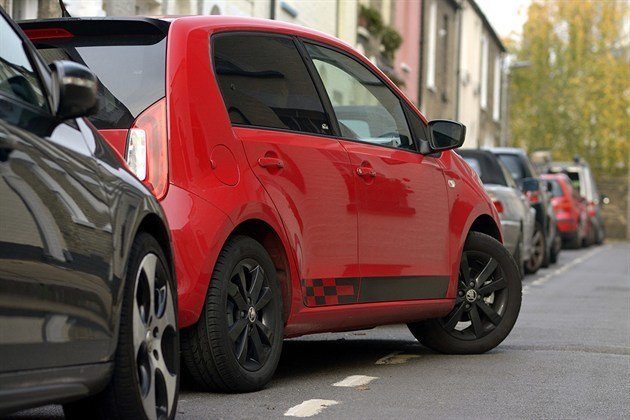
The Citigo works everywhere, but it is at its best in town
When we spend six months with a car it doesn’t take long for a few problems to emerge, but the Citigo managed to keep irritations to a minimum. That’s not to say it’s been entirely problem free - the parcel shelf doesn’t drop on its own and the navigation sometimes freezes up for a few seconds.
There was also an issue with fuses blowing - click here for more on that. This was tracked down to a cheap and nasty phone charger, but it was still frustrating thanks to Skoda’s decision not to provide any spare fuses among the standard equipment. At least fuses are cheap – and the charging socket is hardly essential to road safety.
The problems were all just niggles though – and niggles are to be expected on a car that costs so little. Overall the Citigo has left such a good impression it has become my first choice when people ask me to recommend something small and affordable. It’s cheap to buy, cheap to lease, cheap to insure and cheap to run – but it still feels like a quality car.
In fact it could be the best little car you can buy, especially in the stylish Monte Carlo trim level we’ve had these past six months . It has all the boxes ticked - it’s well made, it has all the essential equipment, it’s spacious for such a little car, it looks good and it drives well. Well played, Skoda. I’d be happy to spend another six months in it.
